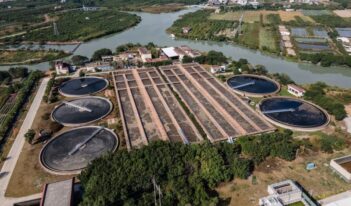
Congressional intent and clear statutory text promote common-sense enforcement of federal water regulations.
In County of Maui v. Hawaii Wildlife Fund, the U.S. Supreme Court put to rest the claim that polluters can evade the Clean Water Act—the principal federal law regulating water pollution— simply by using groundwater as a sewer to convey pollutants to our nation’s rivers, lakes, and oceans.
Maui County had intentionally designed injection wells at its Lahaina wastewater treatment plant to dispose of millions of gallons of partially treated sewage each day by injecting the wastewater into groundwater beneath the facility, knowing that the wastewater would flow with groundwater into the Pacific Ocean. Maui County and the Trump Administration, backed by a rogue’s gallery of polluting industries, argued that polluters can dump wastewater into surface waters with impunity, as long as their pollution travels through groundwater—even for only “two inches”—on its way to surface water.
The Court’s refusal to eviscerate a key safeguard in the Clean Water Act reflects a welcome, and precisely correct, focus on applying the plain text of the law consistent with the U.S. Congress’s clear intent in enacting it.
The Clean Water Act’s sole objective is to “restore and maintain the … integrity of the Nation’s waters.” One of the key ways to accomplish that objective is to require a facility owner or operator to obtain a National Pollutant Discharge Elimination System (NPDES) permit for “any addition of any pollutant to navigable waters from any point source.”
Based on this plain language and congressional intent, the question before the Supreme Court in this case—namely, whether the law exempts from the permit requirement a discharge originating out of a facility pipe or other point source solely because it passes through groundwater—should be straightforward.
Yet the Trump Administration, in a move that reversed decades of prior U.S. Environmental Protection Agency (EPA) practice under both Republican and Democratic administrations, issued an interpretive statement in April 2019 declaring that the permit obligation does not apply to discharges via groundwater. EPA justified this exclusion by claiming that the Clean Water Act’s regulatory safeguards do not typically apply to groundwater. The agency had previously rejected—in prior litigation of the County of Maui case, no less—such an argument as a red herring. Specifically, in a brief to the U.S. Court of Appeals for the Ninth Circuit, EPA regarded the Act’s treatment of groundwater pollution as “beside the point” in cases involving pollution that reaches surface waters routinely covered by the Clean Water Act.
According to the Court, the key statutory interpretation question came down to whether a discharge that travels via groundwater into surface water should be considered an addition of pollutants “from” the original point source. The Court found that common usage of the word “from,” reinforced by the remedial context of the Clean Water Act, readily supports such a reading when the discharge in question is the “functional equivalent of a direct discharge.”
The Court rejected the Trump Administration’s newly minted interpretation—that the addition of a pollutant into groundwater before it is added to surface water alleviates NPDES permitting requirements—because its practical consequences would fundamentally undercut the Clean Water Act’s language and objective. As Justice Stephen Breyer, writing for the six-justice majority, noted about the government’s theory:
If that is the correct interpretation of the statute, then why could not the pipe’s owner, seeking to avoid the permit requirement, simply move the pipe back, perhaps only a few yards, so that the pollution must travel through at least some groundwater before reaching the sea? We do not see how Congress could have intended to create such a large and obvious loophole in one of the key regulatory innovations of the Clean Water Act.
Furthermore, the Court’s holding necessarily rejected an even more sweeping exemption advocated by Maui County and adopted by the U.S. Court of Appeals for the Sixth Circuit in 2018, which would require permits for discharges only when the polluting facility’s pipe or other point source extends all the way into the surface water body.
Justice Breyer’s opinion therefore respects the choices Congress made to adopt a tough law that would control pollution at the source and hold polluters accountable when they seek to evade its requirements.
At the same time, the Court recognized that the Clean Water Act is neither draconian nor unreasonably burdensome, despite some parties’ claims that the mere potential for stiff civil penalties militates in favor of a narrow interpretation of the NPDES permit requirement.
The Court, however, correctly observed that Congress drafted the Clean Water Act to guard against unfair enforcement, reserving harsh penalties for scofflaws and expressly giving judges the discretion to account for good faith efforts to follow the law. In support of this proposition, the Court referred to Section 1319(d) of the statute, which directs judges assessing Clean Water Act penalties to consider factors such as the seriousness of a violation and good faith efforts to comply with the Act’s requirements, as well as “such other matters as justice may require.”
The majority also dismissed claims that complying with Congress’s command to protect our nation’s waters imposes too great a regulatory burden, noting that EPA and states that administer the Act can “mitigate those harms,” for example by “developing general permits for recurring situations.”
At oral argument, Justice Sonia Sotomayor pointedly asked how Maui County is “getting away with” polluting the ocean, noting that “something failed” in the Clean Water Act’s application and enforcement in this case. The Court’s balanced approach in resolving County of Maui v. Hawaii Wildlife Fund provides hope that lower courts will decide future Clean Water Act cases consistent with Congress’s words and purpose—and will not be swayed by overblown rhetoric from polluters wishing to dodge responsibility for keeping the nation’s waters healthy.
This essay is part of a series entitled The Supreme Court’s 2019-2020 Regulatory Term.





